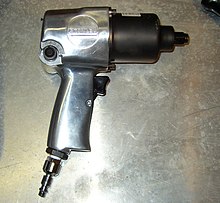Pneumatic screwdriver
A pneumatic screwdriver is a tool that is driven by compressed air and is used to screw in and out screws and nuts.
execution
A compressed air motor drives the work spindle directly or via a gearbox . The torque on the screw connection must be countered. A change in the direction of rotation (clockwise / counterclockwise rotation) is regularly available. In addition, pneumatic screwdrivers can be equipped with a torque setting that interrupts the screwdriving process when the nominal torque is reached. If higher torques are required, a pneumatic screwdriver can also be designed as a pulse screwdriver .
Start of the screwdriver
The starting mechanism opens / closes or throttles the compressed air entering the air motor. When starting the screwdriver there are two common types:
- The screwdriver starts by manually pressing a button or lever (= trigger start or lever start).
- The screwdriver starts up when it is placed on the screw with the mounted tool ( screw bit or socket ) and then pressed onto the screw by hand (= push start).
Advantages and disadvantages
One advantage of the pneumatic screwdriver is its high overload capacity. In the case of electrical devices, overheating can damage the device.
The torque tolerance for pneumatic screwdrivers is significantly larger compared to the tolerances for electric screwdrivers . Furthermore, lubrication of the air motor is required when operating the pneumatic screwdriver. The lubrication usually takes place in the form of oil, which is added to the compressed air via an oiler module built into the air line. During the screwing process, the compressed air exits the screwdriver through the outlet filter. The oil is also released into the ambient air as a finely divided aerosol and can be inhaled by the operator. More recently, however, models that can be operated oil-free have also increasingly been offered. Furthermore, pressure fluctuations can have an influence on the tightening torque achieved. With electric screwdrivers, there is often the option of a soft start. Most pneumatic screwdrivers lack this function.
Mobility is greater with electric screwdrivers, as power tools can also be battery powered and the energy medium electricity is available much more frequently than compressed air and a power cable is perceived as more manageable than a compressed air hose. On the other hand, pneumatic screwdrivers, like other tools operated by compressed air, are more suitable for use in potentially explosive areas, as the drive itself cannot cause sparks.
See also
swell
- ↑ Operating instructions for a ½ ″ pneumatic impact wrench, Westfalia company, as of 06/15
